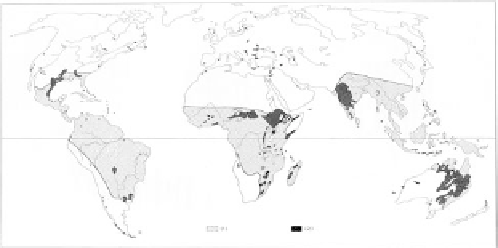Geoscience Reference
In-Depth Information
6.2 ECOLOGY AND TYPOLOGY
Vertisols are mainly found in regions with a rather hot climate but with
very marked alternation of a dry season 4 to 8 months long and a wet
season during the rest of the year. This corresponds to the smectite
region that Georges Millot defined (Chap. 3, Fig. 3.19). Thus it covers
the Mediterranean and dry tropical zones (Fig. 6.5).
Role of climate
Fig 6.5
Areas where Vertisols abound (black) in the regions (grey) with tropical and equato-
rial climates (Dudal 1967;
©
FAO).
The annual rainfall varies over a wide range from 150 mm in Sudan
to 3000 mm in Trinidad, passing through 300 mm in Jordan and 1500
mm in Martinique. But in all these lands, evapotranspiration is high
enough to create a temporary water deficit, even when the total annual
rainfall is high.
These soils occur chiefly in Sudan, East Africa, the Deccan Plateau of
India, USA (Texas, Arkansas, Alabama), South America and Australia.
They are also found in smaller proportion in Italy, Sicily, North Africa
and New Caledonia.
Typically, Vertisols are soils of footslopes. There are two mutually non-
exclusive reasons for this. On the one hand, the silica-rich solutions
accumulate in the footslopes, particularly if there is no drainage outlet
(closed basins, endorheism). This favours the neoformation of 2/1 clay
minerals. On the other hand, the basins are the sites where fine clay
particles can accumulate in lakes through sedimentation.
Let us take the example of Cuba (Paneque y Perez 1984). There the
climate is favourable for formation of Vertisols, at least on marls. But
these soils have features that depend on their topographic position
(Fig. 6.6).
Role of topography

